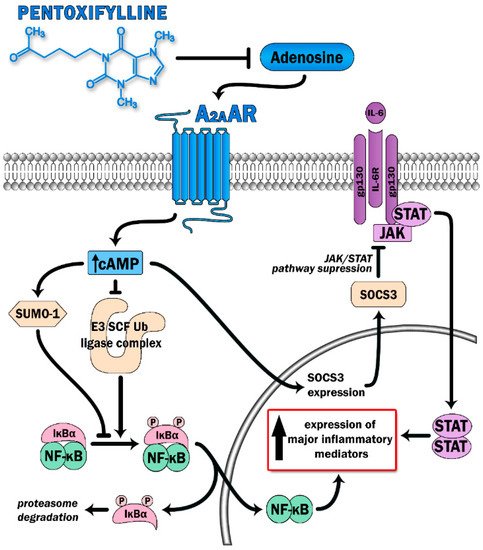The so-called “cytokine storm” refers to the pathologically up-regulated production of various proinflammatory molecules in response to infection or other external stimuli
[5]. This complication involves a loss of negative feedback on immune cells, thus leading to further recruitment of cytokines to the site of inflammation and subsequent organ damage. SARS-CoV-2 pulmonary manifestations are commonly linked to the occurrence of lung tissue dysfunction, such as diffuse alveolar damage, alveolar edema, thickening of alveolar walls, desquamation of pneumocytes, and hyaline membrane formation, all of which are indicative of ARDS
[6] and manifest clinically with disturbed ventilation and hypoxemia. Cytokine storm has been proposed as a primary mechanism responsible for the development of ARDS in COVID-19, exceeding the direct cytopathogenic action of the virus itself
[7]. Chen et al. have demonstrated increased production of the proinflammatory molecules IL-6, IL-2R, IL-10, and TNF-α in COVID-19, showing that they correlate with disease severity
[8]. The IL-6, an important cytokine in viral infections, is further responsible for activation of the coagulation cascade and increased vascular permeability, resulting in an outburst of inflammation
[9]. Furthermore, SARS-CoV-2 S protein can induce IL-6 and TNF-α production in murine macrophages in vitro in an NF-κB-dependent manner
[10].
PTX has been proven to display anti-inflammatory effects and, therefore, was selected as a treatment with potential benefit in countering the COVID-19-mediated cytokine storm. PTX has been considered to boost cAMP levels via the inhibition of phosphodiesterase 4 (PDE-4). The inhibition of the enzyme results in a decreased breakdown of cAMP and further in its increased intracellular levels. Modulation of inflammatory processes by PTX occurs via inhibition of NF-κB, leading to reduced leukocytes–platelets interactions and prothrombotic effects, as well as reduced activation of proinflammatory cytokines and reactive oxygen species
[11]. PDE-4 inhibition has already displayed favorable effects in various conditions, i.e., asthma, chronic obstructive pulmonary disease, and idiopathic pulmonary fibrosis (IPF)
[12]. However, an additional mechanism of action of PTX has recently been proposed. Adenosine A2A receptors (A2ARs) are 7-pass G-protein-coupled receptors that escalate the activity of adenylate cyclase, resulting in increased production of intracellular cAMP in multiple cells, such as neutrophils, macrophages, T-cells, natural killer cells, endothelial cells, and platelets
[13][14]. The ability of A2ARs to diminish inflammatory responses mainly relies upon the deactivation of the two main proinflammatory pathways: the NF-κB and JAK/STAT pathways
[13] (
Figure 1). Increased levels of cAMP contribute to a reduction in the release of oxidants and cytokines, decreased expression of adhesion molecules, decreased generation of tissue factors, and decreased platelet aggregation
[13]. Stimulation of A2ARs further blocks the transition of neutrophils through the lung endothelium, a phenomenon that underlies the pathogenesis of ARDS
[13]. PTX potentiates the response of A2ARs to extracellular adenosine, therefore participating in A2AR-related anti-inflammatory pathways Previously, PTX has been proven to reduce lung inflammation and decrease the number and activity of lung neutrophils in rodent models of hemorrhagic shock, when administrated as an adjuvant therapy to standard fluid resuscitation
[15]. In the same study, PTX regimens resulted in attenuation of the NF-κB activity, possibly through a cAMP-related mechanism
[15]. The capacity of PTX to inhibit TNF-α secretion in vitro has been confirmed through a randomized controlled study of advanced cancer patients diagnosed with ARDS
[16]. The study group was characterized by improvements in both mean survival time and the clinical and radiological symptoms of ARDS, without any serious adverse effects
[16]. PTX has also been shown to attenuate lung injury and improve mortality rates in mice induced to ARDS by increasing cAMP levels and restoring the Treg/Th17 imbalance, in parallel to decreases in IL-2, IL-6, IL-10, and IL-17 secretion
[17]. In a recently published pilot study on patients with a moderate-to-severe SARS-CoV-2 disease course, treatment with PTX led to increases in lymphocyte counts and decreases in serum lactate dehydrogenase (LDH) levels, two biomarkers that are associated with COVID-19 severity
[18] and that are indicators of cytokine storm development
[19]. Lymphocyte depression and fatigue, commonly observed in SARS-CoV-2 infection, occur secondary to overproduction of proinflammatory molecules (TNF-α, IL-6, IL-2, IL-10, and TNF-β)
[20][21][22], while LDH has been described as a prognostic marker in several pulmonary conditions
[23][24][25]. Despite no statistical significance in terms of mortality, days of hospitalization, or the need for intubation, the authors postulate that PTX administration could be of great value in the first-line care of COVID-19 due to its anti-inflammatory properties
[18].

